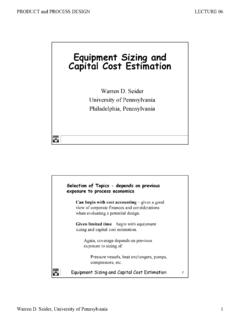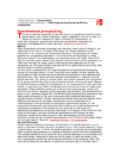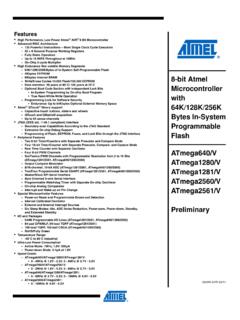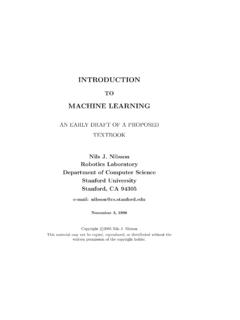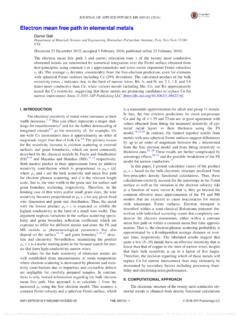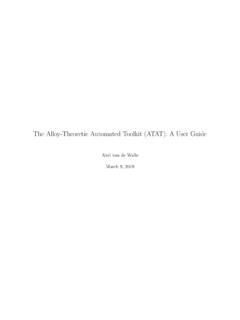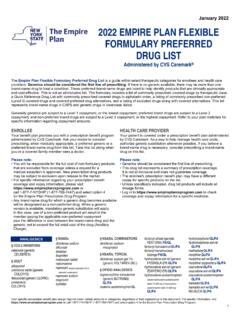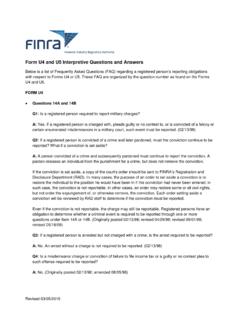Transcription of Thermodynamics of Adsorption - University of Pennsylvania
1 CHAPTER 21 Thermodynamics of AdsorptionALAN L. MYERS1 IntroductionThe attachment of molecules to the surface of a solid by Adsorption is a broad chapter is focused on the Adsorption of gases in high-capacity solid adsorbentssuch as active carbon 1or commercial adsorbents owe their enormouscapacity to an extensive network of nanopores of various shapes (cylinders, slits) withspecific volumes in the range from 100 to 1000 cm3kg 1. Applications of adsorptionexploit the ability of nanoporous materials to adsorb one component of a gas preferen-tially. For example, the preferential Adsorption of nitrogen from air passed through anadsorption column packed with zeolite creates a product stream of nearly pure has the remarkable ability to connect seemingly unrelated prop-erties. For example, the temperature coefficient of Adsorption is directly proportionalto the heat of immersion of the solid adsorbent in the gas. The most important appli-cation of Thermodynamics to Adsorption is the calculation of phase equilibriumbetween a gaseous mixture and a solid basis for thermodynamic calculations is the Adsorption isotherm, which givesthe amount of gas adsorbed in the nanopores as a function of the external isotherms are measured experimentally or calculated from theory usingmolecular functions are used to construct a detailed molecu-lar model for atom atom interactions and a distribution of point charges is used toreproduce the polarity of the solid material and the adsorbing molecules.
2 Recently,ab initioquantum chemistry has been applied to the theoretical determination ofthese potentials, as discussed in another chapter of this applies only to equilibrium Adsorption isotherms. Equilibriummeans that any point can be reached from either direction by raising ( Adsorption ) orlowering (desorption) the pressure at constant temperature. If the desorptionisotherm does not coincide with the Adsorption isotherm, then equilibrium has notbeen achieved and the usual thermodynamic equations do not apply. The mismatchof Adsorption and desorption, which is called hysteresis, does not occur in poressmaller than 2 nm but is observed1when the pores are large enough for the adsorb-ing molecules to condense to a liquid. For Adsorption of supercritical gases or 6/7/2004 3:31 PM Page 243adsorption of subcritical vapors in nanopores, most experiments and simulationsyield equilibrium isotherms with no evidence of simulations yield absoluteadsorption or the actual number of mole-cules in the nanopores.
3 Experiments measure excessadsorption, which is the num-ber of molecules in the nanopores in excess of the amount that would be present inthe pore volume at the equilibrium density of the bulk gas. The difference betweenabsolute and excess Adsorption is negligible at the sub-atmospheric pressures ofgreatest interest. For supercritical gases adsorbed at high pressure ( 100 bar), thedifference between absolute and excess Adsorption is too large to Adsorption Isotherm and Equation of StateWhether the Adsorption isotherm has been determined experimentally or theoreti-cally from molecular simulation, the data points must be fitted with analytical equa-tions for interpolation, extrapolation, and for the calculation of thermodynamicproperties by numerical integration or differentiation. The Adsorption isotherm for apure gas is the relation between the specific amount adsorbed n(moles of gas perkilogram of solid) and P, the external pressure in the gas phase.
4 For now, the dis-cussion is restricted to Adsorption of a pure gas; mixtures will be discussed later. Atypical set of Adsorption isotherms is shown in Figure 1. Most supercriticalisotherms, including these, may be fit accurately by a modified virial (n) exp [C1n C2n2 C3n3 ..](n m)(1)m m nn K244 Chapter 21040801200123P/kPan/mol kg 125 C50 C100 CFigure 1 Adsorption isotherms of C2H4in NaX (zeolite structure FAU), where n is theamountabsorbed and P is the pressure. Points indicate experimental lines indi-cate Equation (1) 6/7/2004 3:31 PM Page 244where Kis the Henry s constant, or the slope of Adsorption isotherm dn/dPat thelimit of zero pressure,mis the saturation capacity (mol kg 1), and the Ciare virialcoefficients, three of which usually suffice to fit the data within experimental the virial coefficients are all zero, Equation (1) reduces to the well-knownLangmuir (1) has the form P(n) so that the inverse function n(P)is implicit.
5 This slight inconvenience is offset by the fact that the implicit form canbe integrated analytically for the thermodynamic functions (see below).The determination of an accurate value for Henry s constant (K) is essential forthe calculation of thermodynamic properties and for mixture calculations. Accordingto Equation (1), a plot of ln(P/n) as a function of nintersects the y-axis at 1/K. If thescatter of the data at low pressure is so large that an accurate value of Kis impossi-ble to determine, then Henry s constant should be measured at a higher is difficult to obtain reliable values of Henry s constants from gravimetric meas-urements because the amount of gas adsorbed at low pressure is given by the differ-ence of two weight measurements that differ by an infinitesimal amount. Volumetricmeasurements are preferred for measuring Henry s constants because the amount ofgas adsorbed is determined by the large difference between the amount of gas dosedto the system and the amount of gas left in the system after of Adsorption isotherms with respect to temperature is based on thethermodynamic equation:7h R n(2)where h is the differential enthalpy of Adsorption , a negative quantity because adsorp-tion is exothermic.
6 The absolute value of h is called isosteric heat . The partial differ-entiation is performed at constant n. In the rigorous equation, the pressure Pis replacedby the fugacity of the gas. The differential enthalpy may be expressed as a polynomial:h (n) D0 D1n D2n2 D3n3 ..(3)The constants Diare assumed to be independent of temperature. For wide variationsin temperature over several hundred degrees Kelvin, this approximation can be cor-rected by introducing heat capacities. The integrated form of Equation (2) isln (constant n)(4)which provides the temperature dependence P(T) given a reference point P*(T*)measured at the same value of n. Combination of Equations (1) and (4) yield anadsorption equation-of-state, which includes the temperature variable:P(n,T) exp exp[C1n C2n2 C3n3 ..](5)where the constants K,m, and the Cirefer to the reference isotherm at T*. The constantsof Equation (5) for the Adsorption isotherms in Figure 1 are:T* K,K T*1 Th (n) Rm m nn K1 T*1 Th (n) RP P* lnP (1/T) Thermodynamics of 6/7/2004 3:31 PM Page 245mol kg 1kPa 1,m mol kg 1,C1 kg mol 1,C2 kg2mol 2,C3 kg3mol 3,D0 kJ mol 1, and D1 kJ kg mol 2.
7 The exper-imental data are compared with Eq. (5) in Figure 2, which includes interpolated andextrapolated isotherms. Logarithmic plots are useful for examining the accuracy of theequation-of-state at low pressure. The calculation of enthalpy, free energy, and entropyfrom these constants is explained in the next , the differential enthalpy is determined from Equation (2) using two ormore Adsorption isotherms. Alternatively, the differential enthalpy can be measureddirectly using a either case, a reference isotherm should be measuredfor the lowest temperature at which an accurate value of the Henry constant can beextracted. In the example shown in Figure 1, the reference isotherm is at 25 C. Fora particular gas and solid, the combination of a reference isotherm with the differ-ential enthalpy provides complete thermodynamic information about the Thermodynamic FunctionsThe grand potential plays a central role in Adsorption Thermodynamics . The grandpotential is defined by F ini i PV(6)where Fis the Helmholtz free energy.
8 The independent variables of the grand potentialare temperature, volume, and chemical potential. These variables are precisely the onesneeded to describe the amount adsorbed from a bulk gas at specified values of temper-ature and chemical potential in a solid adsorbent of fixed volume. For the same reason,molecule simulations of Adsorption are conveniently performed in the grand canonicalensemble for which kTln , where is the grand canonical partition kg 10 C255075100125150175200 CFigure 2 Adsorption isotherms of C2H4in NaX (zeolite structure FAU), where n is the amountadsorbed and P is the pressure. Points indicate experimental lines cal-culated from Equation (5) 6/7/2004 3:31 PM Page 246 For Adsorption of a pure gas, the grand potential is obtained from an isothermalintegration:4 RT P0dP RT n0 Tdn(7) is expressed in J kg 1of solid adsorbent. Physically, the grand potential is the freeenergy change associated with isothermal immersion of fresh adsorbent in the bulkfluid.
9 The absolute value of the grand potential is the minimum isothermal work nec-essary to clean the adsorbent. Since Adsorption occurs spontaneously, the cleaning orregeneration of the adsorbent after it equilibrates with the feed stream is the mainoperating cost of an adsorptive separation extensive thermodynamic property of the system (free energy, enthalpy,entropy, or heat capacity) may be written as the sum of three terms for:1. the value of the property for the adsorbate molecules at the state of the equili-brated bulk gas mixture at {T,P,yi};2. the value of the property for the clean solid adsorbent in vacuoat T; and3. the change in the property associated with immersion of the clean adsorbent inthe bulk gas at constant {T,P,yi}.The thermodynamic functions for items 1 and 2 are calculated using the standardequations for bulk gases and solids, respectively,10so that the focus for adsorptionthermodynamics is on item 3. It follows from Equations (5) and (7) that the grandpotential (free energy of immersion) for each pure component is (n,T) RT m ln 1 C1n2 C2n3 C3n4.
10 D1n2 D2n3 D3n4 .. (8)The constants mand Cirefer to the values for the reference isotherm at T*; the con-stants Direfer to the polynomial for the differential enthalpy in Equation (3). Notethat the free energy is independent of the limiting value of the enthalpy at zero pres-sure,Doin Equation (3).The enthalpy of immersion (H) is the integral of the differential enthalpy (h ):H n0h dn(9)The enthalpy of immersion, like , has units of J kg 1. From Equations (3) and (9):H(n) D0n D1n2 D2n3 D3n4 ..(10)It is convenient to report the enthalpy of immersion as an integral molar enthalpy (Jmol 1) using h H/n:h(n) D0 D1n D2n2 D3n3 ..(11)1 41 31 21 41 31 23 42 31 21 T*1 T1 R3 42 31 2n m lnP lnnn PThermodynamics of 6/7/2004 3:31 PM Page 247 Given the free energy of immersion ( ) and the enthalpy of immersion (H), theentropy of immersion isS (12)4 MixturesThe grand potential provides the standard state for the formation of adsorbed solu-tions from the pure components.
